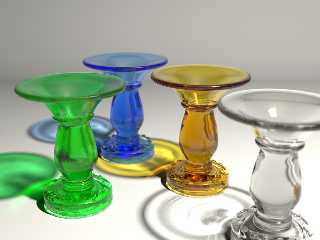|
 |
Am 09.02.2011 04:44, schrieb Robert McGregor:
> According to Wikipedia, Mental Ray's *Dielectric Physical Phenomenon* shader
> "uses Fresnel equations to simulate reflectance and transmittance of light
> passing through the dielectric interface, as well as using Snell's law to
> determine the angle of refraction. In addition Beer's law is used to determine
> absorption of rays passing through dielectric materials."
>
> Well, after looking over some basic dielectric equations I came up with this
> simple POV-SDL setup for the following basic dielectric material in POV-Ray. The
> transparency and reflection of the material automatically tune themselves
> according to the material's IOR value:
>
As I had no time this morning here is a more detailed response:
> //------------------------------------------------------------------------------
> // Dielectric Ball
> /------------------------------------------------------------------------------
> global_settings { photons { spacing 0.01 } }
>
> #declare IOR = 1.33;
> #declare REFL = pow(((1-IOR)/(1+IOR)), 2);
> #declare TRANS = 1 - REFL;
>
> sphere { 0, 1
> texture {
> pigment { rgb 0 transmit TRANS }
> finish {
> reflection {0, REFL fresnel on } conserve_energy
> specular REFL roughness 0.005
> }
> }
> interior { ior IOR }
> photons {
> target
> refraction on
> reflection on
> collect off
> }
> }
>
Sorry, this is pointless. But step by step...
> #declare REFL = pow(((1-IOR)/(1+IOR)), 2);
this is the reflectance when seen *parallel* to the surface normal (or
get 4% reflection and 96% refraction at this angle.
But when seen from a very swallow angle for *every* IOR reflection gets
close to 100% and refraction to 0%. Again for glass, when seen from an
refraction only 1.4%.
Everybody can verify this easily by looking at a *very* swallow angle at
some glass window. The glass becomes an almost perfect mirror.
In POV-Ray-syntax this would be
reflection (REFL, 1) and definitely not reflection (0, REFL)
but it is completely unnecessary to compute the value for REFL because
for this purpose we have the keyword fresnel.
reflection (0, 1 fresnel on)
already calculates exactly e.g. 4% reflection for a given IOR of 1.5 and
The keyword transmit is meant to simulate something like light that
falls through thin paper or through silk or something like this.
To simulate a dielectric it is much better to use filter. It makes
things like colored glass possible and makes it also possible to take
conservation of energy into account and therefor we have the
conserve_energy keyword. So there is no need to calculate something
like
#declare TRANS = 1 - REFL;
especially since the whole point of fresnel reflection is that the
relation between reflected and refracted (or transmitted as you did put
it) rays is not constant but depends on the viewing angle.
A dielectric like window glass within POV-Ray is just as simple as this:
material {
pigment {rgbf 1}
finish {
ambient 0 diffuse 0
reflection {0, 1 fresnel on} conserve_energy
}
interior {ior 1.5}
}
A solution for colored dielectric materials within POV-Ray would be this
macro:
#macro Dielectric (COLOR, IOR)
material {
texture {
pigment {rgb COLOR filter 1}
finish {
ambient 0 diffuse 0
reflection {0 1 fresnel on} conserve_energy
}
}
interior {
ior IOR
fade_power 1001 fade_distance 1/IOR
fade_color rgb <pow(COLOR.red,3), pow(COLOR.green,3),
pow(COLOR.blue,3)>
}
}
photons {
target
refraction on
reflection on
collect off
}
#end
It should even be possible to model something like porcelain (with some
quite high IOR value) but dielectrics like this are more problematic as
light scattering becomes more important.
Attached is a quick dielectric doodle and the source for it.
Note that the environment is (on purpose) quite boring so we have no
interesting reflections on that thingies.
-Ive
Post a reply to this message
Attachments:
Download 'dielectricthing.jpg' (95 KB)
Download 'us-ascii' (5 KB)
Preview of image 'dielectricthing.jpg'

|
 |




![]()